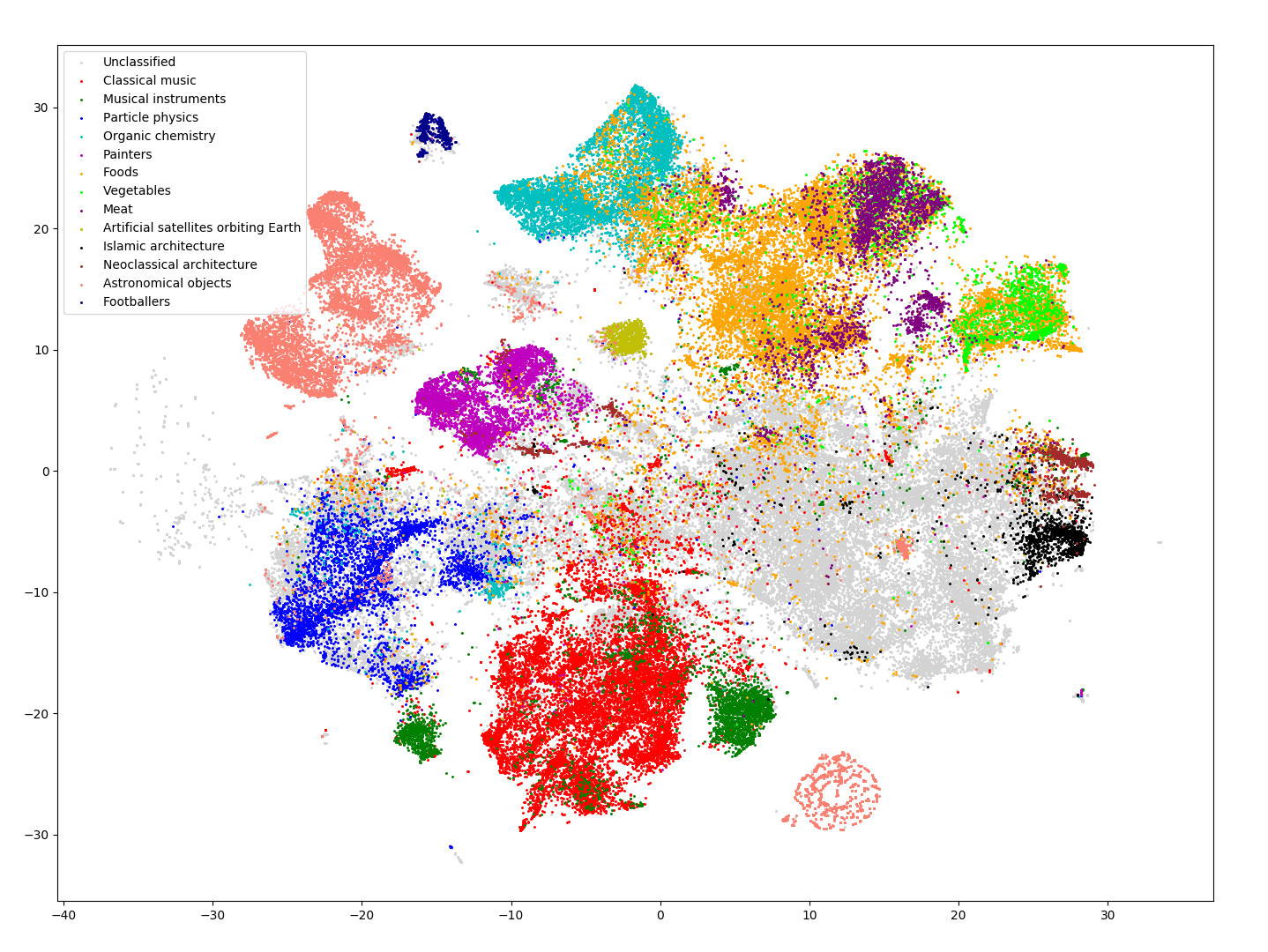Representation is one of the most complex and compelling tasks in machine learning. The way in which we represent facts, events, objects, labels, etc. affects how an autonomous learning agent can analyze them and extract insights, make predictions and deliver knowledge.
In this blog post, we focus on natural language processing and how to represent textual entities such as words, sentences, paragraphs or whole documents. Dealing with text is hard because, from the “algorithm” perspective, it is just a list of strings or characters. If we want to efficiently grab text and use it in various analytics tasks, we need to find simple, meaningful representations that a machine and the algorithms that run on it can understand.
There are several approaches to deal with this challenge. This blog post presents techniques for representing text as a vector. Such representation allows not only to make “mathematical” operations but also to compute distance/similarity. The concepts of similarity and dissimilarity are widely employed in the artificial intelligence domain. They have several applications in data mining, information retrieval, pattern matching, etc. In our specific case we use similarities as a graph construction technique.
Graphs of documents, paragraphs, sentences and words can be created using vector representation and similarity functions. Once the graph is created, link analysis and other graph-specific algorithms can be applied on top of such graphs. Text summarization for instance, can be implemented by PageRank run on the sentences graph.
The better the vector representation, the better the similarity and hence the accuracy of the algorithm deployed on top of it.
Document Embeddings
Using raw text in machine learning algorithms can be approached from various perspectives. It can be as simple as representing documents as bag-of-words (BOW), that is, as an unordered collection of individual words disregarding grammar and the relative position in the document. In this approach the documents are encoded as sparse vectors, where each dimension represents a specific word from the corpus and the value is its document frequency. This model can be extended by using TF-IDF instead of document frequency, where TF is a term frequency (how often that word occurs in the current document) and IDF is an inverse document frequency (the more frequent corpus-wise, the less important it is). Despite simplicity, these traditional methods work well enough for many use cases. However, this representation generates very long and sparse vectors, which suffer from several shortcomings: near orthogonality between two vectors, inability to account for a context and order of words and inability to capture deeper semantic meaning of the document.
What’s out there?
Embeddings are dense vector representations of words or whole documents. They are trained, generally using neural networks, to excel at capturing the contextual and semantic meaning of text, which can then be leveraged as an input into further complex machine learning algorithms, such as neural networks for sentiment analysis.
There are various approaches and countless possible implementations. One of the traditional ones is using so-called autoencoders: deep neural networks which are being forced, by introducing into their internal design a bottleneck layer (see figure) with much lower dimension than the input, to learn a dense low dimensional representation of the input document (represented as sparse BOW vector) which captures its deeper semantic meaning [1].
![Schematic structure of an autoencoder. [2] Schematic structure of an autoencoder. [2]](https://graphaware.com/wp-content/uploads/2024/09/Autoencoder_structure.png)
Concrete implementation can be stacked Restricted Boltzmann Machines (RBMs), Variational Autoencoders (VAEs), or even Convolutional Neural Networks (best known from image classification tasks).
Deep neural networks are not always the best solution. They can introduce unnecessary complexity, resulting in excessive demands on computational power and training data.
On the other hand, shallow neural network models for word and document embeddings have gained significant momentum recent years: rather than complexity, they bet on simplicity because there are no hidden layers. This allows them to be deployed more efficiently on larger volumes of data, resulting in better overall performance than more complex models. An example of such an approach is word2vec [3] for word embeddings, and its extended version Paragraph Vectors [4], which is also known as doc2vec, for document embeddings.
We will focus here on the latter since it is most suitable for representing an entire document and the training process can be customized to serve document classification.
Paragraph Vectors
Basic Concepts
Document embeddings were introduced in [4], where two distinct approaches were presented: Distributed Memory (PV-DM) and Distributed Bag of Words (PV-DBOW).
DM works as follows (see figure below):
- each word is assigned a random vector of specified dimension
- each document (paragraph) is represented by a unique ID and has its own vector
- sliding window algorithm scans through documents (sliding window size represents a context window)
- word and document vectors are concatenated or averaged and used in softmax classifier to predict the next word
- stochastic gradient descent is used to train the vectors and softmax classifier parameters
![Architecture of Paragraph Vectors - Distributed Memory [4] Architecture of Paragraph Vectors - Distributed Memory [4]](https://graphaware.com/wp-content/uploads/2024/09/doc2vec-DM.png)
PV-DBOW architecture works in a very similar fashion, except that the vector representing a paragraph (document) is trained to predict a sequence of words in a small window (see figure below). This model is simpler and requires to store only softmax weights, unlike PV-DM which needs to store also word vectors. Le and Mikolov [4] found that PV-DM is consistently better than PV-DBOW, but that consistently best performance across many tasks is achieved when both vectors are concatenated.
![Architecture of Paragraph Vectors - Distributed BOW [4] Architecture of Paragraph Vectors - Distributed BOW [4]](https://graphaware.com/wp-content/uploads/2024/09/doc2vec-BoW.png)
Paragraph Vectors allow us to represent document as vectors of the overall topics . The learning algorithms manage to capture the semantic substance of documents and can be used as an input for other machine learning tasks instead of the over-simplistic and very sparse BOW vectors. Moreover, just like word vectors, they do behave like real vectors: they can be used in linear translations with other embeddings, including word2vec vectors [5]. For instance:
- vec(Japan) – vec(Sushi) + vec(Germany) ≈ vec(bratwurst)
- vec(Einstein) – vec(scientist) + vec(Picasso) ≈ vec(painter)
- vec(Berlin) – vec(Germany) + vec(France) ≈ vec(Paris)
Implementation
There are various implementations available, for example Gensim: a Python library which does the heavy-lifting in the background in C. We have, however, chosen the DeepLearning4J library, which allows us to seamlessly integrate such features in Hume on top of Neo4j.
The algorithm can be fed with full documents represented as strings (in which case it does a very basic tokenization and only trivial pattern-based lemmatization internally). Here is an example of the procedure call in Hume to train a new model:
CALL ga.nlp.vector.train({type:'doc2Vec', parameters:{query: "MATCH (n:Train) WHERE length(n.text) > 10 WITH n, rand() as r ORDER BY r RETURN n.text as text, id(n) as docId", iterations: 15, epochs: 10, layerSize: 400}}) YIELD result
return result
Note that we use rand() Cypher random number generator function to ensure that documents are shuffled between epochs (neural networks are good at memorizing training data, let’s make that harder for them). To use the trained model to get and store embedding vectors for the entire document, run:
CALL apoc.periodic.iterate('MATCH (s:Wikipage) WHERE length(s.text) > 10 return s',
"CALL ga.nlp.vector.compute({node: s,
type:'doc2Vec',
property:'doc2vec_dim400',
label:'Doc2VecContainerSentence',
parameters: {query:'MATCH (n:HandPicked) WHERE id(n) = {id} RETURN n.text as text', iterations: 10, useExistingAnnotation: False}})
YIELD result
return result", {batchSize: 10, parallel: false})
Alternatively, we can create our own annotations (leveraging, for example, Stanford CoreNLP) and feed it already tokenized and lemmatized tags. This allows for instance to define a better vocabulary used then during the training phase.
CALL ga.nlp.vector.train({type:'doc2Vec', parameters:{query: "match (n:Train)-[:HAS_ANNOTATED_TEXT]->(a:AnnotatedText)-[:CONTAINS_SENTENCE]->(:Sentence)-[:SENTENCE_TAG_OCCURRENCE]->(to:TagOccurrence)-[:TAG_OCCURRENCE_TAG]->(t:Doc2VecVocabulary) with n, t, to order by to.startPosition asc return id(n) as docId, collect(t.value) as tokens", iterations: 15, epochs: 5, layerSize: 400, useExistingAnnotation: True}}) YIELD result
return result
The vocabulary (in the query above represented by tags with label Doc2VecVocabulary) can be constructed, for example, in this way:
match (:Train)
with count(*) as total_docs
match (:Train)-[:HAS_ANNOTATED_TEXT]->(a:AnnotatedText)-[:CONTAINS_SENTENCE]->(:Sentence)-[r:HAS_TAG]->(t:Tag)
with t, count(distinct a) as n_docs, sum(r.tf) as sum_tf, total_docs
where n_docs > 1 and n_docs * 1.0/total_docs < 0.4
with t
order by n_docs desc, sum_tf desc
limit 700000
set t:Doc2VecVocabulary
For constructing and storing embedding vectors, use the same query as for vectors from strings, but set useExistingAnnotation parameter to True and change the query to:
MATCH (n:Wikipage)-[:HAS_ANNOTATED_TEXT]->(a:AnnotatedText)-[:CONTAINS_SENTENCE]->(:Sentence)-[:SENTENCE_TAG_OCCURRENCE]->(to:TagOccurrence)-[:TAG_OCCURRENCE_TAG]->(t:Tag) WHERE id(n) = {id} with to, t order by to.startPosition asc return t.value as token
Evaluation
The main purpose of the vector representation is to create a proper similarity graph model of the documents or sentences. Hence, in order to evaluate the quality of the vectors, we have to evaluate to which extent they are capable of capturing similarity and dissimilarity between documents. We followed the approach in [5] and we used wikipedia pages triplets for evaluating and testing the similarity. The idea is to gather three Wikipedia articles, two are of a very similar topic, one that is of a different (less related) topic, and use doc2vec embedding vectors to decide which of the two articles are more similar based on cosine similarity. For example, articles about Deep Learning and Machine Learning are more similar to each other than to an article about computer networks.
The dataset consists of two sets of triplets: 172 hand-picked triplets and almost 20000 automatically generated triplets (two articles are from the same category, one is from different – potentially sibling – category). We scraped and ingested all of them into Neo4j and used the automatic triplets as a training dataset and the hand picked ones for evaluation. Despite having relatively small training dataset (for comparison: the original paper [4] used full Wikipedia, i.e. ~4.5M pages and the paper [5] used ¼ of Wikipedia), the results are encouraging. Our achieved accuracy surpasses the one reported in [5] and is not far from [4].
Table below contains results for some of our experiments with Paragraph Vectors. We ran multiple tests to check the influence of parameters such as vector dimension, learning rate, number of iterations and epochs and window size on the final quality. The best accuracy achieved was for vector dimension 800 with learning rate 0.025 and 15 iterations, 10 epochs. However, this comes at the cost of serialized model size (9.3 GB!) and requirements on training time and resources (8 hours on one cloud server with 16 cores and 64 GB RAM). A very reasonable alternative is going down to dimension 400, which has just about 2% lower accuracy and took about 2.5 h to compute.
| Dim | Learn. rate | Iter | Epochs | Window | Model size (GB) | Accuracy |
|---|---|---|---|---|---|---|
| 200 | 0.025 | 10 | 10 | 5 | 2.4 GB | 75% |
| 400 | 0.001 | 10 | 10 | 5 | 4.7 GB | 79.6% |
| 400 | 0.001 | 15 | 10 | 5 | 4.7 GB | 82.6% |
| 400 | 0.001 | 15 | 5 | 5 | 4.7 GB | 79.1% |
| 400 | 0.025 | 15 | 5 | 5 | 4.7 GB | 84.3% |
| 400 | 0.025 | 15 | 5 | 8 | 4.7 GB | 83.7% |
| 800 | 0.001 | 15 | 10 | 5 | 9.3 GB | 84.9% |
| 800 | 0.025 | 15 | 10 | 5 | 9.2 GB | 86.6% |
We also tested the influence of sliding window size. In case of dimension 400, increasing the window from 5 to 8 actually resulted in accuracy lower by 0.6%. However, it’s important to note that this difference is not statistically significant. As any other neural network, the important part of the algorithm is the stochastic gradient descent. Therefore, by definition, there is a random element in the procedure and we can get slightly different results each time we run it. After couple of experiments like that, we observed that the reported accuracy has uncertainty around 2-3%. The observed difference between window size 5 and 8 is therefore irrelevant.
DL4J implementation of Paragraph Vectors also allows us to use custom dictionary. We therefore utilised Stanford CoreNLP in our NLP framework to annotate all wikipedia triplets, selected the most relevant words as a dictionary (words occurring at least twice in the corpus and with document frequency below 40%). Thanks to this superior annotation procedure, we ended up with smaller vocabulary, therefore better training performance (smaller model size, less time to train), all this while keeping the same accuracy.
Finally, it should be noted that the reported accuracies are also influenced by the number of iterations used during inferring document vectors from the trained model. By default, it uses the same total number of iterations that were used during training (that is number of epochs times number of iterations). That results in very slow inference. We however observed that using 10 iterations doesn’t deteriorate accuracy by more than ~0.5% (well within accuracy uncertainty discussed above). Going even lower, to 1 iteration, makes the inference about 10x faster, but at the expense of accuracy (drop by ~6% for vector dimension 800). Difference between accuracy as obtained with 10 iterations vs 5 iterations is again about 0.5%, we therefore conclude that the optimal settings is at least 5 inference iterations.
It is always useful to compare these results to some simple benchmark. We used cosine similarity of tf-idf vectors (sparse bag-of-words vectors with each element representing tf-idf value of the word) instead of Paragraph Vectors, which gave us accuracy 77.9%. With doc2vec, we therefore achieved almost 9% accuracy gain with relatively modest training dataset (60k Wikipedia articles)!
Visualisation of Document Embeddings
Due to the amount of data processed, it is useful to find a way to represent visually the results of the analysis using some specific technique. As stated before, representing objects as vectors allows us to make different kind of analyses and visualizations on them. One of them is described here. When we want to visualise high-dimensional data (such as Paragraph Vectors), we need to choose some dimensionality reduction technique to move from high-dimensional space to 2D (potentially 3D) space. The most popular ones are Principal Component Analysis (PCA) and t-SNE.
PCA is a statistical technique that finds such orthogonal transformation of our original possibly correlated variables that best preserves the variance in our data, omitting possibly correlated variables and preserving those that represent the most informative viewpoint on the dataset.
t-SNE is another very useful algorithm for visualising high-dimensional data. It adapts to the underlying data by performing different non-linear transformations on different regions. This produces beautiful plots with well separated clusters, but beware: as a result, the interpretation can be sometimes misleading. The notion of distance is adapted based on regional density variations in the dataset: it tends to expand dense clusters and contract sparse ones, making thus relative cluster size meaningless. Similarly, cluster distances in t-SNE plots may mean nothing, just as random noise can for some parameter choice produce clusters! It is therefore important to always do a scan through the t-SNE parameter space (especially perplexity) to get a better feeling of what is going on. This is a very good article about pitfalls of t-SNE [6].
For very high dimensional data, it is often best performance-wise to combine both approaches: use PCA for reducing dimension to ~50 and then let t-SNE do its magic! This is the approach we chose and the result for full 120k Wikipedia dataset (we ingested 120k articles of specific categories and their subcategories) is shown in following figure.

We can clearly see multiple well defined clusters in our dataset, for example Astronomical objects, Particle physics, Food, Painters, Classical music. Some of the larger clusters are spread over wider area. This can be attributed to too broad topics included in one category. For example, Foods are overlaid with subcategories such as Vegetables and Meat (and others such as Food additives and* Food ingredients), which are quite distinctive for themselves. Similarly for *Musical instruments: they are visualised as two independent clusters, the smaller one being a subcategory Electronic musical instruments. Finally, the large grey blob is a combination of three categories: Countries of Europe / Asia / Africa. These appear to be too vague to create three distinct clusters.
Conclusions
In this blog post, we discussed the importance of a proper document representation. Rather than using the sparse BOW or TF-IDF vectors, we carefully tested and implemented (in Hume) the Paragraph Vectors algorithm. Such a dense document embedding technique is useful for many other advanced machine learning tasks and specifically as an intermediate step for building a significance graph from text of any size.
This blog post also highlights all the effort the Hume team spent on:
- Defining a specific purpose (for instance graph creation for text summarization)
- Selecting a subset of algorithms to evaluate (autoencoders, Paragraph Vectors)
- Implementing, testing and evaluating all of them to find strength and weakness of each of them
- Expose the selected algorithms and the related features
- Further investigate for possible improvements or further usages
Here in the first step we demonstrated that even in relatively modest corpus size the embeddings produce meaningful results and can be useful in grouping documents of similar topic together, simplifying contextual similarity evaluation among various texts. In one of the next blog posts, we will see how they can be leveraged for machine learning classification algorithms.
Bibliography
[1] Hinton G, Salakhutdinov R., “Reducing the Dimensionality of Data with Neural Networks”, Science 2006; 313(5786): 504 – 507, https://www.cs.toronto.edu/~hinton/science.pdf
[2] Wikipedia, “Autoencoder”, https://en.wikipedia.org/wiki/Autoencoder
[3] T. Mikolov, K. Chen, G. Corrado, J. Dean, “Efficient Estimation of Word Representations in Vector Space”, arXiv:1301.3781 [cs.CL]
[4] Q. Le, T. Mikolov, “Distributed Representations of Sentences and Documents”, arXiv:1405.4053 [cs.CL]
[5] A. M. Dai, Ch. Olah, Q. V. Le, “Document Embedding with Paragraph Vectors”, arXiv:1507.07998 [cs.CL]
[6] https://distill.pub/2016/misread-tsne/


